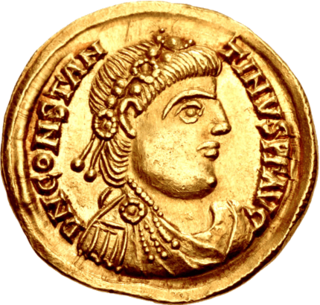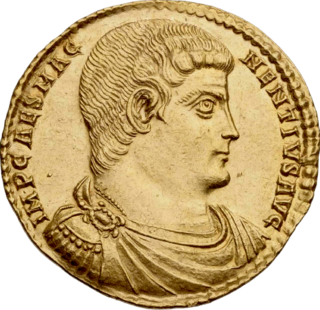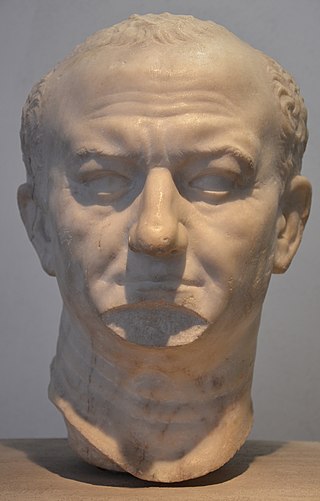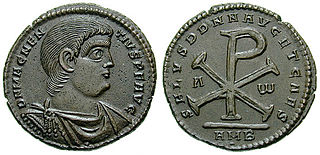This article has an unclear citation style .(May 2024) |
Fabius Titianus was a Roman politician and senator in the fourth century AD.
This article has an unclear citation style .(May 2024) |
Fabius Titianus was a Roman politician and senator in the fourth century AD.
Titianus had a long and successful career as an official; during his life he held many positions in the Empire, including the consulship.
Titianus served as Corrector of Picenum, Proconsul of the province of Sicily (dates unknown), and Proconsul of Asia (between 324 and 337 AD). In 337 AD, he was elected consul together with Flavius Felicianus as his colleague. [1]
After the death of Constantine I, he continued to serve under Constantine's youngest son, Constans, serving as Urban Prefect of Rome from 339 to 341 AD. From 341 or 342 AD, until the end of Constans' reign in 350 AD, Titianus was Praetorian Prefect of Gaul. [2]
He supported the rebellion of the usurper Magnentius, for which he was again appointed Urban Prefect of Rome, holding the office from 350 to 351 AD. Shortly before the Battle of Mursa, Titianus arrived at the court of Constantius II as the ambassador of Magnentius. He accused the Constantinian dynasty of allowing the destruction of cities through negligence and advised him to abdicate in favor of Magnentius. Constantius rejected the proposal, but Titianus was freely released back to Magnentius. [1]
Titianus was known to have been a pagan. He was a Quindecimviri sacris faciundis in a priestly college.

Constantius II was Roman emperor from 337 to 361. His reign saw constant warfare on the borders against the Sasanian Empire and Germanic peoples, while internally the Roman Empire went through repeated civil wars, court intrigues, and usurpations. His religious policies inflamed domestic conflicts that would continue after his death.

Flavius Julius Constans, also called Constans I, was Roman emperor from 337 to 350. He held the imperial rank of caesar from 333, and was the youngest son of Constantine the Great.

Constantine II was Roman emperor from 337 to 340. Son of Constantine the Great and co-emperor alongside his brothers, his attempt to exert his perceived rights of primogeniture led to his death in a failed invasion of Italy in 340.

Constantine III was a common Roman soldier who was declared emperor in Roman Britain in 407 and established himself in Gaul. He was recognised as co-emperor of the Roman Empire from 409 until 411.

Magnus Magnentius was a Roman general and usurper against Constantius II. Of Germanic descent, Magnentius served with distinction in Gaul under the emperor Constans. On 18 January 350 Magnentius was acclaimed Augustus. Quickly killing the unpopular Constans, Magnentius gained control over most of the Western Empire. The Eastern emperor Constantius II, the brother of Constans, refused to acknowledge Magnentius' legitimacy and led a successful campaign against Magnentius. Ultimately, Magnentius' forces were scattered after the Battle of Mons Seleucus, and he committed suicide on 10 August 353.

Flavius Claudius Constantius Gallus was a statesman and ruler in the eastern provinces of the Roman Empire from 351 to 354, as Caesar under emperor Constantius II, his cousin. A grandson of emperor Constantius Chlorus and empress Flavia Maximiana Theodora, and a son of Julius Constantius and Galla, he belonged to the Constantinian dynasty. Born during the reign of his uncle Constantine the Great, he was among the few male members of the imperial family to survive the purge that followed Constantine's death. Under Constantius II, Gallus served as deputy emperor, based in Antioch and married to Constantius' sister Constantina. He dealt with a Jewish revolt in the years 351-352. Gallus ultimately fell out of favor with Constantius and was executed, being replaced as Caesar by his younger half-brother Julian.

Constans II was the son of Western Roman emperor Constantine III, and served as his co-emperor from 409 to 411. Constans was a monk prior to his father being acclaimed emperor by the army in Britain in early 407, an act of rebellion against the ruling emperor Honorius. He was summoned to Gaul, appointed to the position of caesar (heir) and swiftly married so that a dynasty could be founded. In Hispania, Honorius's relatives rose in 408 and expelled Constantine's administration. An army under the generals Constans and Gerontius was sent to deal with this and Constantine's authority was re-established. Honorius acknowledged Constantine as co-emperor in early 409 and Constantine immediately raised Constans to the position of augustus (emperor), theoretically equal in rank to Honorius as well as to Constantine. Later in 409 Gerontius rebelled, proclaimed his client Maximus emperor and incited barbarian groups in Gaul to rise up. Constans was sent to quash the revolt, but was defeated and withdrew to Arles. In 410, Constans was sent to Hispania again. Gerontius had strengthened his army with barbarians and defeated Constans; the latter withdrew north and was defeated again and killed at Vienne early in 411. Gerontius then besieged Constantine in Arles and killed him.

Vetranio was briefly Western Roman emperor in 350, allying with the Eastern emperor Constantius II in his war against Magnentius.

The gens Flavia was a plebeian family at ancient Rome. Its members are first mentioned during the last three centuries of the Republic. The first of the Flavii to achieve prominence was Marcus Flavius, tribune of the plebs in 327 and 323 BC; however, no Flavius attained the consulship until Gaius Flavius Fimbria in 104 BC. The gens became illustrious during the first century AD, when the family of the Flavii Sabini claimed the imperial dignity.
The Battle of Mursa was fought on 28 September 351 between the eastern Roman armies led by the Emperor Constantius II and the western forces supporting the usurper Magnentius. It took place at Mursa, near the Via Militaris in the province of Pannonia. The battle, one of the bloodiest in Roman history, was a pyrrhic victory for Constantius.

Flavia Valeria Constantina, later known as Saint Constance, was the eldest daughter of Roman emperor Constantine the Great and his second wife Fausta, daughter of Emperor Maximian. Constantina may have received the title of Augusta from her father, and is venerated as a saint, having developed a medieval legend wildly at variance with what is known of her actual character.

Marcellinus was a Roman Empire officer under Roman Emperor Constans and usurper Magnentius.
Valerius Maximus was a Roman senator.

This article chronicles the attested movements of the fourth-century Roman emperors Constantine II, Constantius II, Constans, Gallus, and Julian the Apostate from 337 to 361 AD. It does not cover the imperial usurpers of the period, including Magnentius, Vetranio, Claudius Silvanus, and Poemenius. The chronology is principally derived from Timothy Barnes' Athanasius and Constantius. Substantial additions and further sources are based on recent research that seeks to go beyond Barnes' own chronology and slightly modifying his at a few places.

The Roman civil war of 350–353 AD was a war fought between the Roman emperor Constantius II and the usurper Magnentius.
Ulpius Limenius was a Roman politician who was appointed consul in AD 349.
Seleucus also known as Flavius Seleucus and Count Seleucus was a wealthy Greek rhetor who was a close friend of Libanius and the Roman emperor Julian.
Flavius Romulus was a Roman politician, appointed to the high position of consul in 343. The historian Benet Salway tentatively identified him with Romulus, the senior army officer who fought and died for the usurper Magnentius at the Battle of Mursa in 351.
Memmius Vitrasius OrfitussignoHonorius was a Roman politician.
Mecilius Hilarianus was a Roman politician and senator in the fourth century AD.